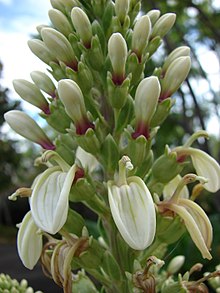Lobelia

Lobelia (/loʊˈbiːliə, lə-/[4][5][6]) is a genus of flowering plants comprising 415 species,[7] with a subcosmopolitan distribution primarily in tropical to warm temperate regions of the world, a few species extending into cooler temperate regions.[8] They are known generally as lobelias.[9]
Description
The genus Lobelia comprises a substantial number of large and small annual, perennial and shrubby species, hardy and tender, from a variety of habitats, in a range of colours. Many species appear totally dissimilar from each other. However, all have simple, alternate leaves and two-lipped tubular flowers, each with five lobes. The upper two lobes may be erect while the lower three lobes may be fanned out. Flowering is often abundant and the flower colour intense, hence their popularity as ornamental garden subjects.[10]
Taxonomy
The genus Lobelia was first formally described in 1753 by Carl Linnaeus in Species plantarum and was named after the Flemish botanist Matthias de Lobel (1538–1616).[11][12][13]
Lobelia is probably the base form from which many other lobelioid genera are derived; it is therefore highly paraphyletic and not a good genus in a cladistic sense. For example, the Hawaiian species (see Hawaiian lobelioids), currently classified in several genera, originated from a single introduction to a now-submerged Hawaiian Island 15 million years ago, probably from an Asian Lobelia in Lobelia subg. Tupa.[14]
A New Zealand study concluded that local species of Hypsela, Isotoma and Pratia should be treated as Lobelia.[15]
Ecology
Lobelia species are used as food plants by the larvae of some Lepidoptera species including the Setaceous Hebrew Character.
